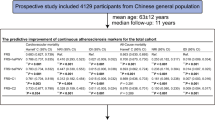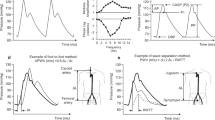Abstract
Currently, there is no recommendation regarding the minimum number of pulse wave velocity (PWV) measurements to optimize individual's cardiovascular risk (CVR) stratification. The aim of this study was to examine differences between three single consecutive and averaged PWV measurements in terms of the extrapolated CVR and the classification of aortic stiffness as normal. In 60 subjects who referred for CVR assessment, three repeated measurements of blood pressure (BP), heart rate and PWV were performed. The reproducibility was evaluated by the intraclass correlation coefficient (ICC) and mean±s.d. of differences. The absolute differences between single and averaged PWV measurements were classified as: ⩽0.25, 0.26–0.49, 0.50–0.99 and ⩾1 m s−1. A difference ⩾0.5 m s−1 (corresponding to 7.5% change in CVR, meta-analysis data from >12 000 subjects) was considered as clinically meaningful; PWV values (single or averaged) were classified as normal according to respective age-corrected normal values (European Network data). Kappa statistic was used to evaluate the agreement between classifications. PWV for the first, second and third measurement was 7.0±1.9, 6.9±1.9, 6.9±2.0 m s−1, respectively (P=0.319); BP and heart rate did not vary significantly. A good reproducibility between single measurements was observed (ICC>0.94, s.d. ranged between 0.43 and 0.64 m s−1). A high percent with difference ⩾0.5 m s−1 was observed between: any pair of the three single PWV measurements (26.6–38.3%); the first or second single measurement and the average of the first and second (18.3%); any single measurement and the average of three measurements (10–20%). In only up to 5% a difference ⩾0.5 m s−1 was observed between the average of three and the average of any two PWV measurements. There was no significant agreement regarding PWV classification as normal between: the first or second measurement and the averaged PWV values. There was significant agreement in classification made by the average of the first two and the average of three PWV measurements (κ=0.85, P<0.001). Even when high reproducibility in PWV measurement is succeeded single measurements provide quite variable results in terms of the extrapolated CVR and the classification of aortic stiffness as normal. The average of two PWV measurements provides similar results with the average of three.
This is a preview of subscription content, access via your institution
Access options
Subscribe to this journal
Receive 12 digital issues and online access to articles
$119.00 per year
only $9.92 per issue
Buy this article
- Purchase on Springer Link
- Instant access to full article PDF
Prices may be subject to local taxes which are calculated during checkout

Similar content being viewed by others
References
Mattace-Raso FU, van der Cammen TJ, Hofman A, van Popele NM, Bos ML, Schalekamp MA et al. Arterial stiffness and risk of coronary heart disease and stroke: the Rotterdam Study. Circulation 2006; 113 (5): 657–663.
Inoue N, Maeda R, Kawakami H, Shokawa T, Yamamoto H, Ito C et al. Aortic pulse wave velocity predicts cardiovascular mortality in middle-aged and elderly Japanese men. Circ J 2009; 73 (3): 549–553.
Willum-Hansen T, Staessen JA, Torp-Pedersen C, Rasmussen S, Thijs L, Ibsen H et al. Prognostic value of aortic pulse wave velocity as index of arterial stiffness in the general population. Circulation 2006; 113 (5): 664–670.
Laurent S, Cockcroft J, Van Bortel L, Boutouyrie P, Giannattasio C, Hayoz D et al. Expert consensus document on arterial stiffness: methodological issues and clinical applications. Eur Heart J 2006; 27 (21): 2588–2605.
Urbina EM, Williams RV, Alpert BS, Collins RT, Daniels SR, Hayman L et al. Noninvasive assessment of subclinical atherosclerosis in children and adolescents: recommendations for standard assessment for clinical research: a scientific statement from the American Heart Association. Hypertension 2009; 54 (5): 919–950.
Frimodt-Moller M, Nielsen AH, Kamper AL, Strandgaard S . Reproducibility of pulse-wave analysis and pulse-wave velocity determination in chronic kidney disease. Nephrol Dial Transplant 2008; 23 (2): 594–600.
Wilkinson IB, Fuchs SA, Jansen IM, Spratt JC, Murray GD, Cockcroft JR et al. Reproducibility of pulse wave velocity and augmentation index measured by pulse wave analysis. J Hypertens 1998; 16 (12 Part 2): 2079–2084.
Mattace-Raso FUHA, Verwoert GC, Wittemana JC, Wilkinson I, Cockcroft J, McEniery C et al. Determinants of pulse wave velocity in healthy people and in the presence of cardiovascular risk factors: ′establishing normal and reference values’. Eur Heart J 2010; 31 (19): 2338–2350.
Mancia G, De Backer G, Dominiczak A, Cifkova R, Fagard R, Germano G et al. 2007 ESH-ESC Practice Guidelines for the Management of Arterial Hypertension: ESH-ESC Task Force on the Management of Arterial Hypertension. J Hypertens 2007; 25 (9): 1751–1762.
Asmar R, Topouchian J, Pannier B, Benetos A, Safar M . Pulse wave velocity as endpoint in large-scale intervention trial. The Complior study. Scientific, Quality Control, Coordination and Investigation Committees of the Complior Study. J Hypertens 2001; 19 (4): 813–818.
Vlachopoulos C, Aznaouridis K, Stefanadis C . Prediction of cardiovascular events and all-cause mortality with arterial stiffness: a systematic review and meta-analysis. J Am Coll Cardiol 2010; 55 (13): 1318–1327.
Wilkinson IB, McEniery CM, Schillaci G, Boutouyrie P, Segers P, Donald A et al. ARTERY Society guidelines for validation of non-invasive haemodynamic measurement devices: Part 1, arterial pulse wave velocity. Artery Res 2010; 4: 34–40.
Bland JM, Altman DG . Statistical methods for assessing agreement between two methods of clinical measurement. Lancet 1986; 1 (8476): 307–310.
Bartko JJ . The intraclass correlation coefficient as a measure of reliability. Psychol Rep 1966; 19 (1): 3–11.
Papaioannou TG, Karatzis EN, Karatzi KN, Gialafos EJ, Protogerou AD, Stamatelopoulos KS et al. Hour-to-hour and week-to-week variability and reproducibility of wave reflection indices derived by aortic pulse wave analysis: implications for studies with repeated measurements. J Hypertens 2007; 25 (8): 1678–1686.
Landis JR, Koch G . The measurement of observer agreement for categorical data. Biometrics 1977; 33: 159–174.
Anderson SG, Sanders TA, Cruickshank JK . Plasma fatty acid composition as a predictor of arterial stiffness and mortality. Hypertension 2009; 53 (5): 839–845.
Blacher J, Guerin AP, Pannier B, Marchais SJ, Safar ME, London GM . Impact of aortic stiffness on survival in end-stage renal disease. Circulation 1999; 99 (18): 2434–2439.
Choi CU, Park EB, Suh SY, Kim JW, Kim EJ, Rha SW et al. Impact of aortic stiffness on cardiovascular disease in patients with chest pain: assessment with direct intra-arterial measurement. Am J Hypertens 2007; 20 (11): 1163–1169.
Cruickshank K, Riste L, Anderson SG, Wright JS, Dunn G, Gosling RG . Aortic pulse-wave velocity and its relationship to mortality in diabetes and glucose intolerance: an integrated index of vascular function? Circulation 2002; 106 (16): 2085–2090.
Laurent S, Boutouyrie P, Asmar R, Gautier I, Laloux B, Guize L et al. Aortic stiffness is an independent predictor of all-cause and cardiovascular mortality in hypertensive patients. Hypertension 2001; 37 (5): 1236–1241.
Meaume S, Benetos A, Henry OF, Rudnichi A, Safar ME . Aortic pulse wave velocity predicts cardiovascular mortality in subjects >70 years of age. Arterioscler Thromb Vasc Biol 2001; 21 (12): 2046–2050.
Mitchell GF, Hwang SJ, Vasan RS, Larson MG, Pencina MJ, Hamburg NM et al. Arterial stiffness and cardiovascular events: the Framingham Heart Study. Circulation 2010; 121 (4): 505–511.
Pannier B, Guerin AP, Marchais SJ, Safar ME, London GM . Stiffness of capacitive and conduit arteries: prognostic significance for end-stage renal disease patients. Hypertension 2005; 45 (4): 592–596.
Shokawa T, Imazu M, Yamamoto H, Toyofuku M, Tasaki N, Okimoto T et al. Pulse wave velocity predicts cardiovascular mortality: findings from the Hawaii-Los Angeles-Hiroshima study. Circ J 2005; 69 (3): 259–264.
Terai M, Ohishi M, Ito N, Takagi T, Tatara Y, Kaibe M et al. Comparison of arterial functional evaluations as a predictor of cardiovascular events in hypertensive patients: the Non-Invasive Atherosclerotic Evaluation in Hypertension (NOAH) study. Hypertens Res 2008; 31 (6): 1135–1145.
Wang KL, Cheng HM, Sung SH, Chuang SY, Li CH, Spurgeon HA et al. Wave reflection and arterial stiffness in the prediction of 15-year all-cause and cardiovascular mortalities: a community-based study. Hypertension 2010; 55 (3): 799–805.
Zoungas S, Cameron JD, Kerr PG, Wolfe R, Muske C, McNeil JJ et al. Association of carotid intima-medial thickness and indices of arterial stiffness with cardiovascular disease outcomes in CKD. Am J Kidney Dis 2007; 50 (4): 622–630.
Shoji T, Emoto M, Shinohara K, Kakiya R, Tsujimoto Y, Kishimoto H et al. Diabetes mellitus, aortic stiffness, and cardiovascular mortality in end-stage renal disease. J Am Soc Nephrol 2001; 12 (10): 2117–2124.
Boutouyrie P, Tropeano AI, Asmar R, Gautier I, Benetos A, Lacolley P et al. Aortic stiffness is an independent predictor of primary coronary events in hypertensive patients: a longitudinal study. Hypertension 2002; 39 (1): 10–15.
Sutton-Tyrrell K, Najjar SS, Boudreau RM, Venkitachalam L, Kupelian V, Simonsick EM et al. Elevated aortic pulse wave velocity, a marker of arterial stiffness, predicts cardiovascular events in well-functioning older adults. Circulation 2005; 111 (25): 3384–3390.
Author information
Authors and Affiliations
Corresponding author
Ethics declarations
Competing interests
The authors declare no conflict of interest.
Rights and permissions
About this article
Cite this article
Papaioannou, T., Protogerou, A., Nasothimiou, E. et al. Assessment of differences between repeated pulse wave velocity measurements in terms of ‘bias’ in the extrapolated cardiovascular risk and the classification of aortic stiffness: Is a single PWV measurement enough?. J Hum Hypertens 26, 594–602 (2012). https://doi.org/10.1038/jhh.2011.76
Received:
Revised:
Accepted:
Published:
Issue Date:
DOI: https://doi.org/10.1038/jhh.2011.76
Keywords
This article is cited by
-
Adverse Childhood Experiences (ACEs) Predict Increased Arterial Stiffness from Childhood to Early Adulthood: Pilot Analysis of the Niagara Longitudinal Heart Study
Journal of Child & Adolescent Trauma (2020)
-
Oscillometric assessment of arterial stiffness in everyday clinical practice
Hypertension Research (2017)
-
Mean arterial pressure values calculated using seven different methods and their associations with target organ deterioration in a single-center study of 1878 individuals
Hypertension Research (2016)
-
A region-matching method for pulse transit time estimation: potential for improving the accuracy in determining carotid femoral pulse wave velocity
Journal of Human Hypertension (2015)
-
No significant effect of angiotensin II receptor blockade on intermediate cardiovascular end points in hemodialysis patients
Kidney International (2014)



